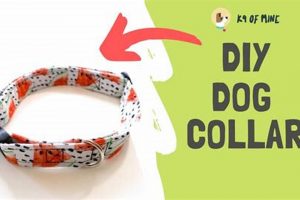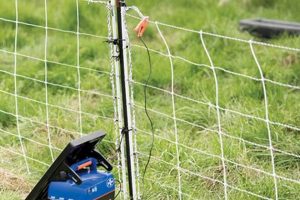Construction of an indoor canine waste receptacle offers a practical solution for pet owners seeking to manage their dog’s elimination needs within the confines of their home. This involves creating a contained area, often using materials such as wood, plastic, or metal, designed to hold absorbent pads or artificial turf for urine and fecal matter collection. The resulting product provides a designated indoor location, reducing the likelihood of accidents on floors or furniture.
Fabricating such a system presents several advantages. It can provide a consistent and predictable elimination area, particularly beneficial for puppies undergoing house training or older dogs with mobility issues. A dedicated indoor waste station reduces the need for frequent outdoor trips, which is valuable during inclement weather or for owners with limited accessibility. Historically, these have evolved from simple newspaper layouts to more sophisticated and aesthetically pleasing designs that integrate seamlessly into home decor.
The following sections will delve into specific material selections, construction methodologies, and maintenance protocols associated with building these canine waste management systems, providing a detailed guide for creating a functional and personalized solution. Considerations for size, drainage, and odor control will also be addressed.
Constructing an Indoor Canine Waste Receptacle
Effective design and construction of an indoor canine waste receptacle requires careful planning and execution. The following guidelines provide essential insights for maximizing functionality and longevity.
Tip 1: Material Selection is Paramount: Employ durable, non-porous materials such as polypropylene or treated wood to resist moisture absorption and bacterial growth. Proper sealing of joints is critical.
Tip 2: Implement an Adequate Drainage System: Design the base with a slight gradient and drainage holes to facilitate the removal of excess liquid. A removable collection tray beneath the main structure simplifies cleaning.
Tip 3: Incorporate Odor Control Measures: Select materials known for their odor-resistant properties. Furthermore, consider integrating a replaceable carbon filter system within the structure’s design to minimize unpleasant smells.
Tip 4: Prioritize Size and Accessibility: Accurately assess the dog’s size and mobility limitations to determine appropriate dimensions. Ensure the entry point is low and wide enough for comfortable access, particularly for older or smaller breeds.
Tip 5: Consider Surface Texture for Comfort: If using artificial turf, opt for a high-quality, pet-friendly variety that mimics the feel of natural grass. Avoid abrasive surfaces that could irritate the dog’s paws.
Tip 6: Emphasize Ease of Cleaning: Design the system for easy disassembly and cleaning. Detachable components and smooth, accessible surfaces are crucial for maintaining hygiene.
Tip 7: Secure the Base: Prevent sliding or tipping by attaching non-slip pads to the base. This enhances stability and protects flooring.
These guidelines collectively ensure the creation of a functional, hygienic, and user-friendly indoor waste system for canines. Careful attention to detail in material selection, drainage, odor control, and accessibility contributes to the overall effectiveness and acceptance of the system by both pet and owner.
The concluding section will address optimal placement and introduce effective training techniques to acclimate the dog to the new indoor elimination area.
1. Material Durability
Material durability is a cornerstone of effective indoor canine waste receptacle construction. The choice of materials directly affects the lifespan, hygiene, and overall practicality of the resulting system. Using substandard, porous, or chemically unstable materials leads to premature degradation from constant exposure to urine, fecal matter, and cleaning solutions. This necessitates frequent replacements, increased maintenance, and a higher risk of unsanitary conditions. For example, untreated wood quickly absorbs urine, fostering bacterial growth and emitting foul odors, whereas a sealed, non-porous plastic resists absorption and is easily sanitized.
The selection of durable materials directly influences the economic viability of the project. An initial investment in high-quality, resistant substances, such as marine-grade plywood coated with epoxy resin or high-density polyethylene (HDPE) plastic, translates into long-term cost savings by reducing the need for repairs or replacements. Furthermore, durable materials withstand frequent cleaning cycles without warping, cracking, or dissolving, preserving the structural integrity of the receptacle over extended periods. Stainless steel, for example, offers excellent corrosion resistance and is often used for components requiring regular disinfection.
In conclusion, prioritizing material durability is not merely a matter of aesthetics but a fundamental requirement for building a functional and sustainable indoor canine waste system. The long-term benefits of selecting robust, resistant materials far outweigh the initial cost, resulting in a hygienic, low-maintenance, and economically sound solution. Compromising on material quality ultimately undermines the effectiveness of the entire system.
2. Drainage Efficiency
Drainage efficiency constitutes a critical parameter in the functional design of an indoor canine waste receptacle. Inadequate drainage promotes the accumulation of urine, creating an environment conducive to bacterial proliferation and the generation of unpleasant odors. This, in turn, compromises hygiene and potentially impacts the health of both the animal and human occupants of the dwelling. Efficient drainage mitigates these issues by rapidly channeling liquid waste away from the surface, minimizing contact time and reducing the opportunities for microbial growth. A well-designed system incorporates appropriate sloping, strategically positioned drainage holes, and a collection reservoir to facilitate the effective removal of fluids.
The implementation of effective drainage solutions varies depending on the materials and construction methods employed. For example, a tray constructed from molded plastic may incorporate integrated channels and a central drain leading to a removable collection container. In contrast, a wooden structure may require a waterproof liner and a series of drilled drainage holes. The size and number of drainage apertures must be carefully calculated to accommodate the anticipated volume of liquid waste. The collection reservoir should be readily accessible for emptying and cleaning to prevent the build-up of sediment and the formation of biofilms, further contributing to odor control and hygiene.
In summation, drainage efficiency is not merely a desirable feature but a fundamental necessity for a functional and sanitary indoor canine waste management system. Neglecting this aspect compromises the overall effectiveness of the receptacle, potentially leading to hygiene issues and increased maintenance requirements. Proper design and construction, incorporating appropriate materials and drainage mechanisms, are essential for creating a long-lasting and hygienic solution for indoor pet waste management.
3. Odor Mitigation
Effective odor mitigation is an indispensable element of any successful “dog potty tray diy” project. The decomposition of canine waste, particularly urine, generates ammonia and other volatile organic compounds that contribute to unpleasant smells within a household. The selection of appropriate materials and incorporation of specific design features directly influences the extent to which these odors are contained and neutralized. Without adequate odor control, an indoor waste receptacle becomes an olfactory nuisance, negating many of the benefits of a dedicated indoor elimination area.
Strategies for minimizing odors in a “dog potty tray diy” construct include the use of non-porous materials, such as treated plastics or sealed wood, to prevent the absorption of urine and the subsequent harboring of bacteria. Incorporating a drainage system facilitates the rapid removal of liquid waste, reducing the time available for decomposition. The inclusion of a replaceable carbon filter, positioned within the tray’s structure, adsorbs odor-causing molecules from the surrounding air. Furthermore, the regular cleaning of the tray with appropriate enzymatic cleaners neutralizes residual odors and inhibits bacterial growth. For example, a simple tray constructed from untreated wood and lacking drainage will quickly become a source of persistent and offensive smells, while a properly designed and maintained system can remain relatively odor-free for extended periods.
In summation, odor mitigation is not an optional add-on, but an intrinsic requirement for a functional and acceptable indoor canine waste system. A comprehensive approach, encompassing material selection, design features, and maintenance protocols, is essential for minimizing unpleasant smells and ensuring the successful integration of a “dog potty tray diy” solution into a domestic environment. Neglecting odor control compromises the practicality and desirability of the entire project.
4. Size Appropriateness
The dimensioning of a self-constructed canine indoor waste station is not arbitrary. Appropriately scaled dimensions directly influence the comfort, usability, and effectiveness of the system, impacting both the canine user and the human caregiver. A mismatch between the receptacle size and the dog’s physical needs can lead to avoidance, accidents, and ultimately, the failure of the training endeavor.
- Length and Width Relative to Dog’s Stance
The internal dimensions of the receptacle must accommodate the dog’s natural elimination posture. A dog should be able to comfortably turn around and position itself within the tray without stepping outside its boundaries. Smaller breeds require less space, while larger breeds necessitate significantly larger surface areas. Insufficient length or width may cause the dog to partially eliminate outside the intended zone, defeating the purpose of the system. For example, a Great Dane will require a substantially larger tray than a Dachshund.
- Entry Height and Accessibility
The height of the receptacle’s entry point should be carefully considered, particularly for puppies, senior dogs, or breeds prone to joint problems. A high entry threshold can deter use due to physical limitations. A ramp or a lowered edge can facilitate easy access, encouraging consistent utilization. An overly high entry point can pose a risk of injury, while an appropriately low entry promotes comfort and confidence during elimination.
- Depth of the Containment Area
The depth of the tray or containment area should be sufficient to contain the chosen absorbent material (e.g., pee pads, artificial turf) and prevent overflow. An inadequate depth may lead to urine leakage, resulting in unsanitary conditions and unpleasant odors. Conversely, an excessively deep tray may be cumbersome to clean and potentially intimidating for smaller dogs. The optimal depth strikes a balance between containment capacity and ease of maintenance.
- Overall Footprint within the Living Space
The exterior dimensions of the “dog potty tray diy” creation must be congruent with the available space within the home. A disproportionately large receptacle may dominate a room, creating an obstruction and negatively impacting the aesthetics of the living environment. Conversely, a system that is too small may be ineffective. Careful measurement and consideration of spatial constraints are crucial to ensure that the receptacle integrates seamlessly into the designated location without compromising functionality or convenience.
These considerations collectively highlight the importance of tailoring the dimensions of a “dog potty tray diy” project to the specific needs of both the canine user and the human environment. An appropriately sized receptacle maximizes usability, promotes hygiene, and ensures the long-term success of the indoor elimination solution. Neglecting size appropriateness can undermine the entire endeavor, leading to frustration and potential failure.
5. Training Consistency
Consistent training is paramount to the successful integration of an indoor canine waste receptacle into a dog’s routine. Even the most meticulously crafted “dog potty tray diy” structure will prove ineffective without a dedicated and unwavering training regimen. A lack of consistency breeds confusion, leading to accidents outside the designated area and undermining the intended purpose of the indoor waste solution.
- Establishment of a Regular Potty Schedule
A structured elimination schedule is foundational for successful training. Taking the dog to the indoor receptacle at predictable intervals, such as after waking up, after meals, and before bedtime, establishes a clear association between the location and the desired behavior. Regularity reinforces the habit and reduces the likelihood of unplanned eliminations elsewhere in the home. Failing to maintain a consistent schedule disrupts this association, potentially leading to setbacks in the training process.
- Positive Reinforcement and Reward Systems
Positive reinforcement techniques are instrumental in motivating the dog to use the indoor waste receptacle. Immediately rewarding the dog with praise, treats, or a favorite toy upon successful elimination within the designated area strengthens the association between the action and the positive consequence. Conversely, punishment for accidents is counterproductive, creating anxiety and potentially hindering the training process. The consistent application of positive reinforcement accelerates learning and promotes a positive attitude toward the indoor waste solution.
- Clear and Consistent Verbal Cues
Assigning a specific verbal cue, such as “go potty” or “do your business,” to the act of elimination can further enhance the training process. Consistently using this cue when taking the dog to the indoor receptacle establishes a direct link between the command and the desired behavior. The dog eventually learns to associate the cue with the act of elimination, facilitating more reliable compliance. Variability in verbal cues can cause confusion and slow down the training progress.
- Immediate and Appropriate Cleaning of Accidents
Prompt and thorough cleaning of any accidents outside the designated receptacle is essential to prevent the establishment of undesirable elimination habits. Using enzymatic cleaners specifically designed to neutralize pet odors eliminates residual scents that might attract the dog to repeat the behavior in the same location. Neglecting to clean accidents effectively can reinforce the habit of eliminating in inappropriate areas, undermining the training efforts associated with the indoor waste receptacle.
In conclusion, training consistency is not merely a supplementary aspect of “dog potty tray diy,” but a foundational requirement for its success. The implementation of a structured schedule, positive reinforcement, clear verbal cues, and prompt accident cleanup collectively reinforces the desired behavior and promotes the effective utilization of the indoor waste solution. A failure to prioritize training consistency diminishes the value of the most well-constructed receptacle, rendering it an ineffective tool for managing canine elimination needs.
Frequently Asked Questions
The following section addresses common inquiries regarding the construction and implementation of indoor waste solutions for dogs, providing clarity on essential aspects of design, functionality, and training.
Question 1: What materials are most suitable for constructing a durable and hygienic indoor canine waste receptacle?
Ideal materials exhibit non-porous properties, resistance to moisture absorption, and ease of cleaning. High-density polyethylene (HDPE) plastic, marine-grade plywood sealed with epoxy resin, and stainless steel are commonly employed due to their durability and resistance to degradation from urine and cleaning agents.
Question 2: How can odor control be effectively integrated into the design of an indoor waste system?
Odor control strategies include utilizing odor-resistant materials, implementing an efficient drainage system to minimize urine accumulation, incorporating a replaceable carbon filter to adsorb odor-causing molecules, and employing enzymatic cleaners during routine maintenance.
Question 3: What considerations are paramount when determining the appropriate size of an indoor waste receptacle?
The dimensions should accommodate the dog’s size and elimination posture, allowing it to comfortably turn around and position itself within the tray. Entry height should be accessible, particularly for puppies or senior dogs. The depth of the containment area must be sufficient to hold absorbent materials without overflow, while the overall footprint must be congruent with the available space.
Question 4: What is the recommended methodology for training a dog to use an indoor waste receptacle?
Training involves establishing a regular elimination schedule, utilizing positive reinforcement techniques (praise and treats) upon successful elimination, assigning a clear and consistent verbal cue, and promptly cleaning any accidents outside the designated area with enzymatic cleaners.
Question 5: How frequently should an indoor canine waste receptacle be cleaned?
Cleaning frequency depends on the size of the dog, the type of absorbent material used, and the ambient temperature. However, a general guideline is to empty and disinfect the collection tray daily and thoroughly clean the entire receptacle at least once per week to prevent odor buildup and bacterial growth.
Question 6: What are the potential drawbacks of utilizing an indoor canine waste system, and how can they be mitigated?
Potential drawbacks include odor issues, hygiene concerns, and difficulties in training. These can be mitigated through proper material selection, efficient drainage, consistent cleaning, appropriate training techniques, and diligent monitoring of the system’s functionality.
Addressing these frequently asked questions provides a foundation for understanding the complexities of indoor canine waste management. Implementing these best practices contributes to the successful integration of an indoor waste solution into a domestic environment.
The subsequent section will explore advanced design considerations for maximizing the functionality and aesthetic appeal of canine indoor waste systems.
Dog Potty Tray DIY
The preceding discourse has meticulously examined various facets of constructing an indoor waste management system for canines. Topics encompassing material selection, drainage efficiency, odor mitigation, size appropriateness, and training consistency have been explored in detail. The importance of each element in creating a functional and hygienic solution has been underlined, emphasizing the necessity for a comprehensive approach to “dog potty tray diy”.
The construction of an effective “dog potty tray diy” requires meticulous planning and consistent execution. A thoughtfully designed and rigorously maintained system can significantly improve the quality of life for both pet and owner. Individuals embarking on such a project should carefully consider the information presented, prioritizing both the animal’s needs and the long-term sustainability of the implemented solution. The commitment to these considerations dictates the overall success and lasting value of the endeavor.







